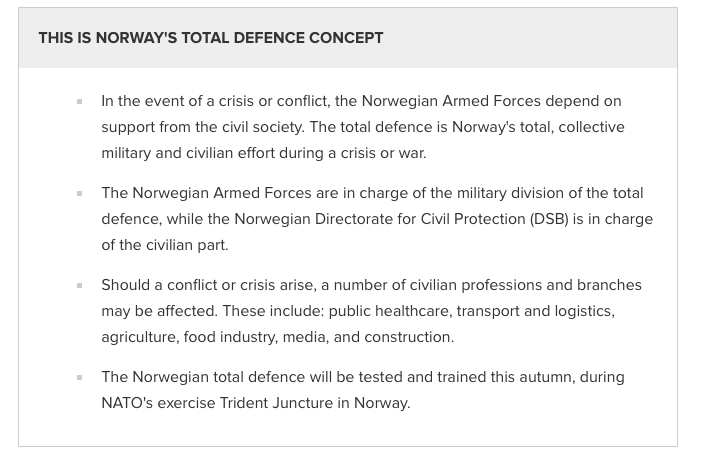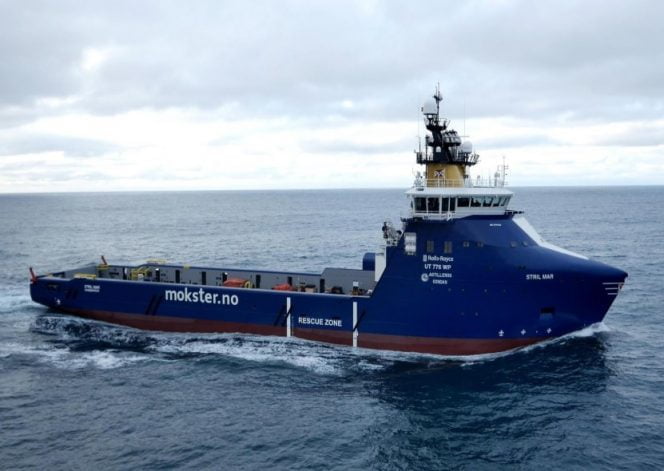The return of direct defense to Northern Europe as seen Sweden restore conscription, the Finns move closer to the United States, the Danes increasing defense spending and the Norwegians emphasizing their “total defence concept.”
As the Norwegian Ministry of Defence has defined this approach:

An example of how Norway is working its Total Defence Concept was highlighted in this article published on November 2, 2018 by Naval Today.
The Norwegian defense ministry is using commercial vessels to test a new concept of operations as part of the 31-nation NATO drill Trident Juncture which is taking place in Norway.
Norwegian company Simon Møkster has disclosed that its offshore supply vessel Stril Mar is taking part in the exercise and is helping the country test the Total Defence Concept, which involves military forces and a wide range of civilian departments and authorities.
Stril Mar has been taken out of her normal operation and in addition to the civilian crew, the vessel has a military crew from MARCSS (Maritime Combat Service Support). The vessel will be used as a platform for easy maintenance and fuel supply and logistics support.
This civil-military concept is called STUFT (ship taken out of trade). The concept implies that one takes a civilian ship out of normal operation, so that it can be used to support military departments at sea.
“To be able to test this capacity during Trident Juncture will enable the Armed Forces to support vessels that are in operation in a better way. Immediately, we will test the preparedness and civil society’s ability and willingness to support the Armed Forces in the framework of the total defense,” says MARCSS, Kommandør Kaptein Frode Staurset.
Naval Today has contacted the Norwegian defense ministry to ask how many commercial ships or what other non-military sectors could be expected to take part in the concept test but we are yet to receive a response. In an earlier announcement, the ministry said it has signed contracts with Norwegian companies worth more than NOK 1.5 billion (USD 180 million, EUR 160 million) for various services supporting the drill.
And in a November 2, 2018 article published by NATO, the Norwegian approach was highlighted as well.
TRONDHEIM, Norway – Exercise TRIDENT JUNCTURE 18 is using a fictitious scenario where Norway has been attacked, and due to such an attack on the Alliance, NATO Response Forces respond quickly subsequently enabling the northern country to test their Total Defence Concept in the process.
Co-operation between the Norwegian Armed Forces and the Norwegian Directorate for Civil Protection (DSB) is extremely close and Exercise TRIDENT JUNCTURE 18 has provided a platform to test and reinforce civil defensive procedures and assess national vulnerabilities and preparedness.
“Norway is a very safe country, but world security has and is changing rapidly and the Total Defence Concept is key in order to cope with all challenges,” said Morten Harangen, DSB Deputy Head of Communication. “It has taken steady progress to develop such close cooperation with our Norwegian Armed Forces and other agencies.”

In any crisis or conflict, both military and civilian authorities must work together, especially in times of cyber aggression or other hybrid activity. These close working relationships across all spectrums of Norwegian national life form a Total Defence Concept that enables extensive unity of effort.
“Exercise TRIDENT JUNCTURE 18 provides us with a unique opportunity to test our Host Nation capabilities and the Defence Concept, reflecting extremely close co-operation and synchronisation,” said Cecilie Daae, Director General DSB. “It has been an essential exercise to test our procedures in order to safeguard our Norwegian population,” she added.
The Norwegian Total Defence Concept has been fully integrated into all aspects of Exercise TRIDENT JUNCTURE 18 activity and in the phases completed so far, has proved an outstanding success. In the future, further DSB activity and exercises will involve mass casualty situations and emergency services, followed by other scenarios such as environmental and natural disasters.
Sweden has a similar concept as well.
In this 2017 by Fredrik Lindgren and Ann Odlund, the Swedish approach and its evolution was examined.
http___webbrapp.ptn.foi.se_pdf_cb1cc21f-26c9-4738-a70f-9c81b92c0744


